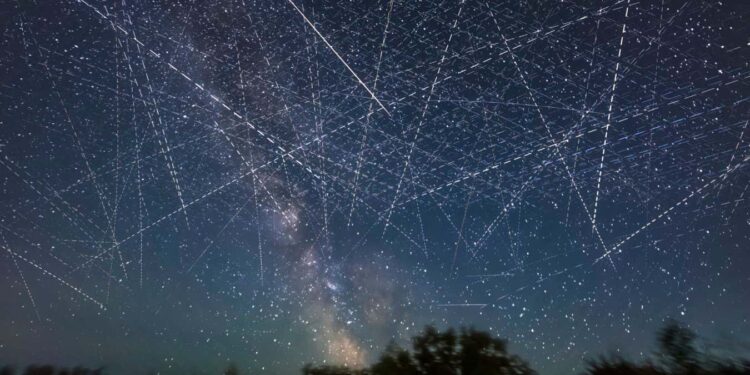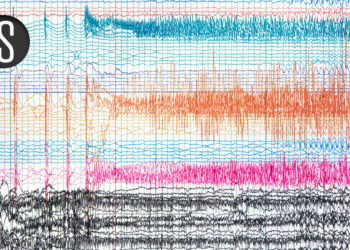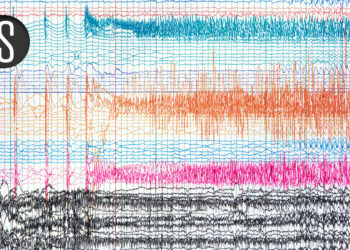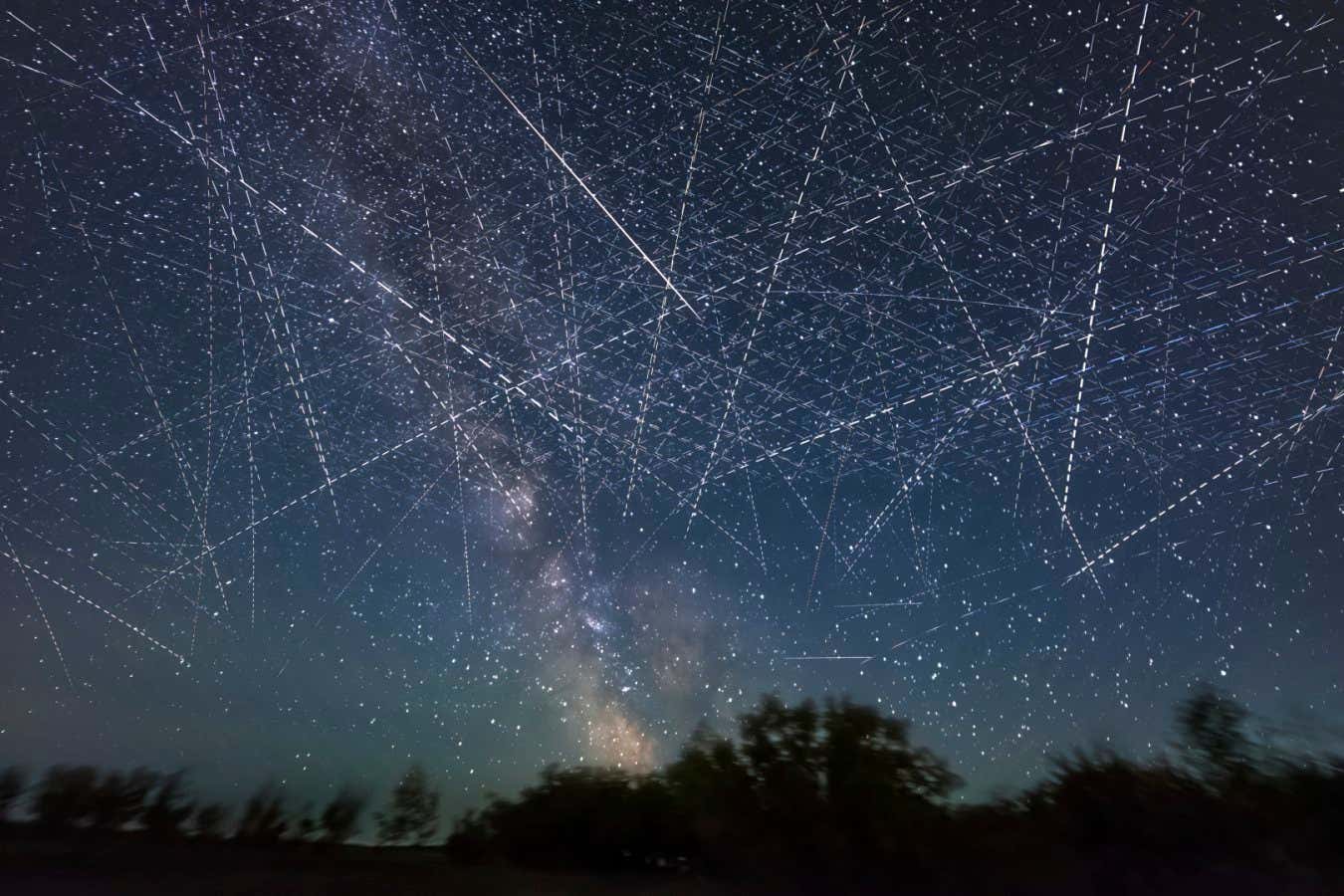
This view of the night sky is a composite of images taken over a period of just 30 minutes – showing just how many satellites are now in orbit
ALAN DYER/VW PICS/SCIENCE PHOTO LIBRARY
Think of pollution and your mind’s eye might conjure up images of smoke-spewing chimneys, car exhausts and those sewer outflows you see on beaches. What probably doesn’t spring to mind is the mesosphere, a slice of sky far above the height any aeroplane flies. And yet a growing chorus of scientists are sounding the alarm that this could be the site of a worrying new form of pollution.
There are currently more than 15,000 satellites zooming around our planet, and almost all are destined to be de-orbited, a euphemistic way of saying they will burn up in the atmosphere. In doing so, they will release clouds of metals, soot and reactive chemicals that could have worrying effects, including damaging our protective ozone layer. “It is like a mini geoengineering experiment,” says atmospheric chemist Eloise Marais at University College London.
Few scientists think this is causing serious harm just yet. The trouble is, it soon could be, as the number of satellites continues to soar. That is why researchers are now rushing to get a handle on this problem and figure out exactly what this new pollution consists of, what its effects will be and what we can do about it.
Over the past decade or so, satellite designs have been miniaturised and the cost of launching them has plummeted, thanks to the rise of reusable rockets. Both factors have led to the launch of a huge number of satellites (see chart below). Foremost among them is the Starlink megaconstellation, which currently consists of around 8000 satellites used to provide broadband internet. These objects are in low Earth orbit, many at an altitude of approximately 550 kilometres.
The number of satellites is expected to keep growing fast. Amazon is developing a rival to Starlink called Project Kuiper, which currently has around 100 satellites and approval to launch some 3000 in total. China is doing likewise, with plans to grow its version, called Guowang, to 13,000 satellites. Add up all the plans and it seems that low Earth orbit could get a lot more crowded very quickly. Some estimates suggest there could be a further 70,000 satellites there by 2030.
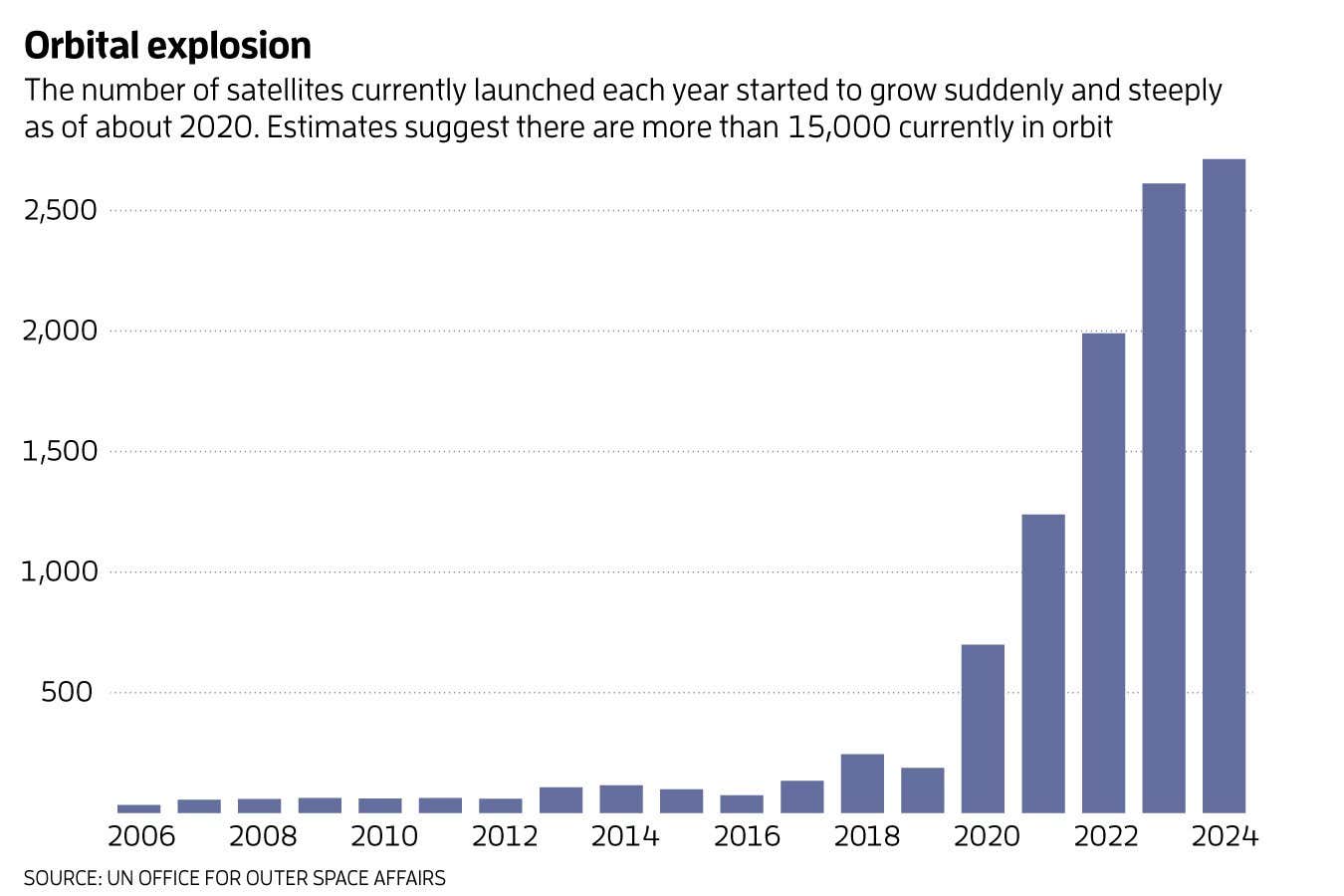
Why does this pose a problem? The lifetime of these satellites is often only about five years, partly because they are designed to carry limited fuel, which they require to stay aloft, and partly because operators want to keep upgrading their fleets with newer, more capable tech. To prevent the old satellites from cluttering near-Earth space, risking collisions, they direct them into the atmosphere to burn up.
At the moment, we aren’t talking about a vast amount of material. According to the European Space Agency, about three old satellites or rocket stages perish in the atmosphere every day. Astrophysicist Jonathan McDowell at the Harvard–Smithsonian Center for Astrophysics in Massachusetts, who tracks satellite launches and re-entries, says he estimates that around 900 tonnes of space debris may be vaporising in the upper atmosphere every year. This equates to 5 per cent or so of the mass injected naturally by meteoroids.
Satellite pollution
That may not sound troubling, but researchers worry about the cocktail of human-made materials satellites leave behind. One of the big concerns is aluminium, which constitutes up to two-fifths of the average satellite. When burned in air, aluminium is converted to aluminium oxide, commonly known as alumina. We have known for many years that alumina particles in the atmosphere react with and deplete ozone, the gas known for absorbing ultraviolet radiation from the sun that would otherwise be harmful to life. In the 1990s, researchers found that the alumina released from solid rocket boosters used in Space Shuttle launches caused miniature, temporary ozone holes in the stratosphere minutes after each of those rocket passages. On top of that, alumina is reflective, and so can influence atmospheric temperature. We know that about 10 per cent of aerosol particles in the stratosphere contain aluminium and other metals emanating from the burn-up of satellites and rocket stages.
Satellite de-orbiting also produces black carbon or soot, which directly absorbs sunlight, and so warms the atmosphere. True, industry on the ground produces vastly more soot than satellite pollution does, but there is a complication that could make the latter far more damaging. Satellites typically burn up in the mesosphere at an altitude of 50 to 80 kilometres. It is thought that particulates injected here can potentially stay in circulation, gradually filtering down through the atmosphere, for years, depending on their size and composition.
As they slowly descend to Earth, they pass through the stratosphere, where most of the planet’s protective ozone resides, potentially triggering ozone depletion. “Rain cleans up the lower atmosphere fairly quickly,” says Marais, “but up there, it’s much more conducive to accumulating.” A 2022 study led by her and her colleagues estimated that, due to its long lifetime in the atmosphere, soot released at high altitudes from rockets burning the most common type of rocket fuel may be up to 500 times more warming than that emitted by cars or passenger planes. New Scientist contacted both Amazon and Starlink to ask about their views on satellite pollution generally. Starlink did not respond and Amazon gave no comment.
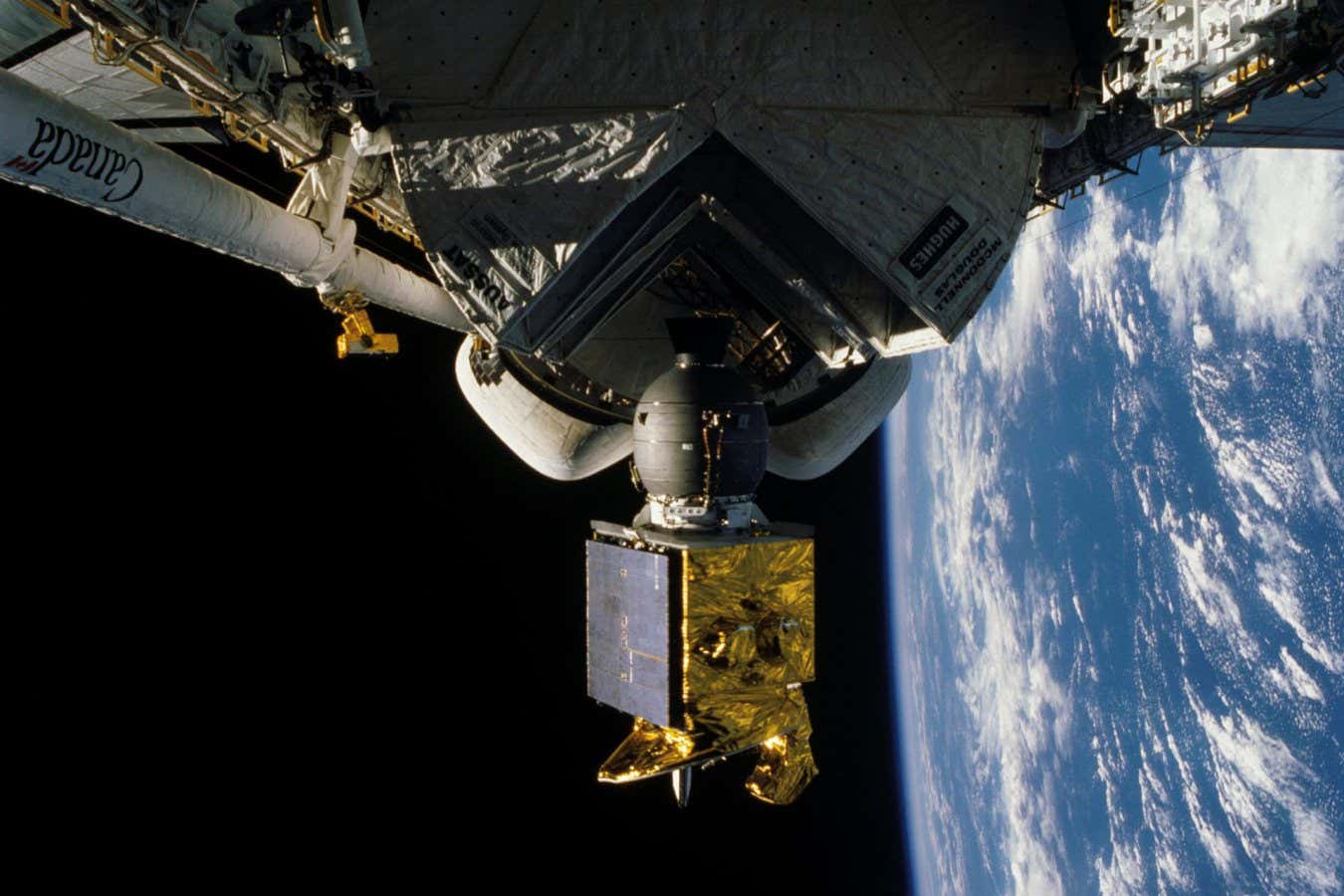
Today’s satellites are now far smaller and cheaper to launch than their counterparts from just a few decades ago
JSC/NASA
Space sector emissions inventories suggest that prior to 2020, metal and soot pollution levels in the atmosphere were growing by about 6 per cent per year, according to Conor Barker, one of Marais’s colleagues at University College London. But more recent data reveal this type of pollution is now growing more than three times as quickly. This could have dramatic consequences for Earth’s environment. “Every year, we are seeing those emissions getting bigger,” says Barker. “Especially since 2020, the growth has been quite steep and getting steeper as we see many more satellites launched and de-orbited and larger rockets pumping more pollutants into the upper atmosphere.”
Other researchers are turning their attention to modelling the large-scale effects these pollutants might have on Earth’s climate. Earlier this year, a team of researchers led by Christopher Maloney at the University of Colorado Boulder used computer simulations to model what would happen if the number of short-lifetime satellites in orbit were to exceed 60,000 – well within the limits of existing predictions. The researchers found that the corresponding rise in concentration of atmospheric alumina would see the mesosphere warm by 1.5°C, and there would also be a 10 per cent reduction in speed in the high-level winds of the southern hemisphere polar vortex.
Maloney emphasises that these results shouldn’t be taken as a hard and fast prediction. “Even though we used alumina in our simulation, there is not even a general consensus about what type of aluminium products we are going to get,” he says. Other possibilities include aluminium monoxide and aluminium hydroxide, which may be less harmful than the ozone-depleting alumina. But his team’s results do suggest there is potential for satellite pollution to have a measurable effect on the dynamics of the atmosphere.
Atmospheric chemist John Plane at the University of Leeds, UK, says that existing predictions of the space industry’s growth suggest that the amount of incinerated space trash could easily grow by a factor of 50 within the next decade. Scientists have just a few years to get ahead of the problem. “These processes need to be explored in the laboratory so that we have the necessary physiochemical data to model them properly,” he says.
Wind tunnel studies
One of those doing exactly that is Stefan Löhle, who heads the plasma wind tunnel laboratory at the University of Stuttgart in Germany. For 20 years, he and his team have used wind tunnels to ensure spacecraft survive atmospheric re-entry. But recently they have turned their interest towards satellites deliberately designed for a fiery death, in an effort to properly understand the physical process of disintegration.
Using a 5-metre-long wind tunnel, Löhle and his colleagues melt chunks of aluminium in a flow of plasma mimicking the fiery conditions during a satellite re-entry at altitudes of 60-80 kilometres. They compare the light given off by the chunks in the tunnel with spectroscopic measurements of real satellite break-ups obtained from Earth and from a handful of aircraft observation campaigns conducted in recent years. They then tweak the conditions in the tunnel until the simulated spectra match the real thing – and then analyse what happens in detail.
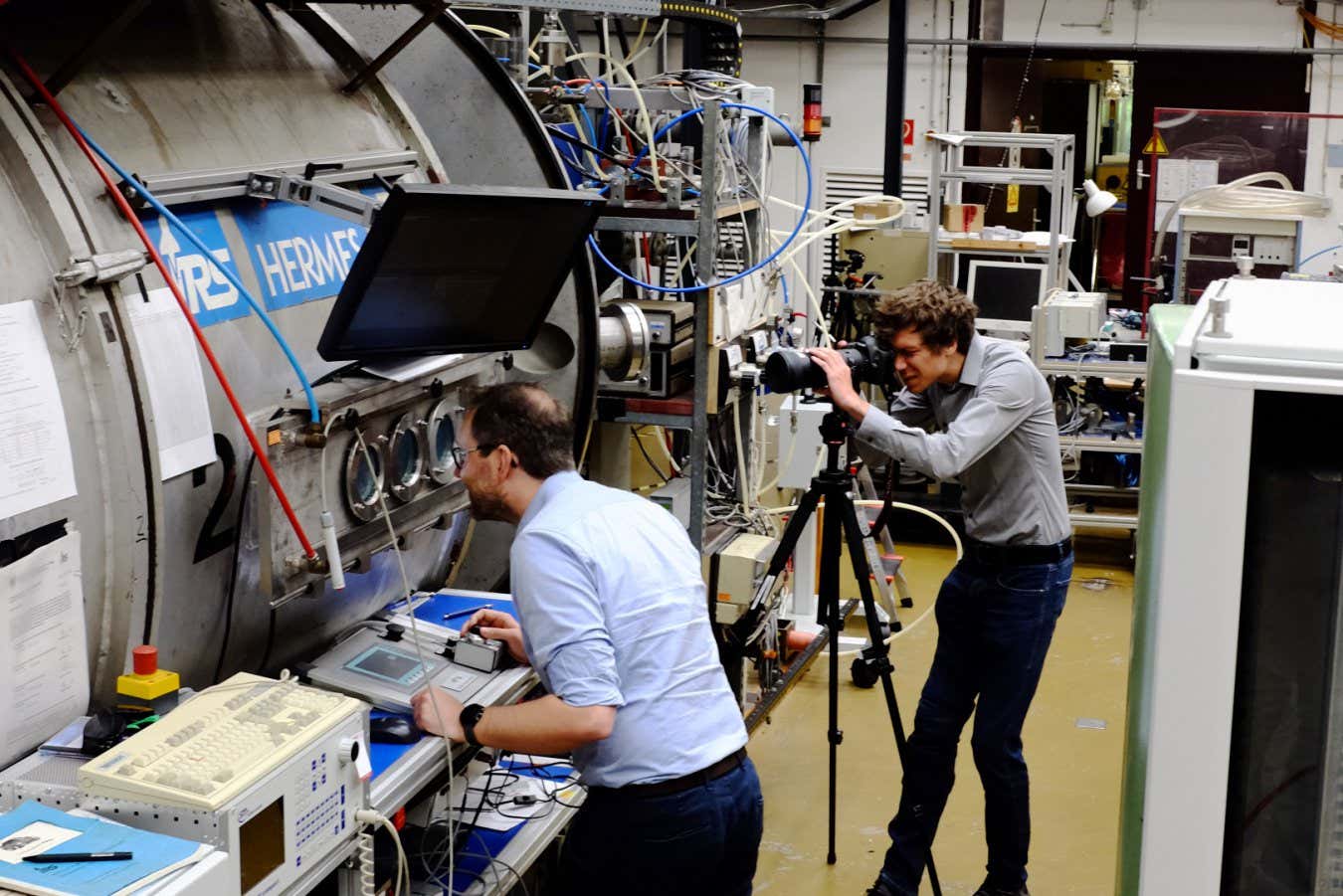
The plasma wind tunnel laboratory at the University of Stuttgart is being used to simulate how satellites burn up in the atmosphere
Stefan Loehle
Although humankind has been burning stuff in space for almost 70 years, observations of satellite re-entries from Earth and from aircraft have so far revealed very little about this fiery process. Löhle says satellite demise begins at 120 kilometres and is mostly complete at 50 kilometres above Earth. “You have an aluminium structure that melts and forms droplets. But not all of these droplets completely evaporate into aluminium oxides. Some of them may condense into solid particles, nanometre or micrometre in size, and just float down to the ground where they won’t be harmful.”
Understanding the exact nature of these particles, their shapes, sizes and subsequent interactions with the atmosphere, is the goal of this research. That, in turn, will inform the work of modellers such as Barker, Marais or Maloney, who will have more accurate inputs for their climate impact studies.
A circular economy in space
Löhle’s work could also help with one possible solution to the problem of satellite pollution. In principle, simply changing the trajectory of a satellite as it de-orbits could change the air resistance it experiences and so how it burns up, potentially reducing the amount and composition of material left behind. One of the next steps for Löhle and his team will be to experiment with modifying the conditions in the wind tunnel to mimic various re-entry trajectories and investigate what happens. Studies like this could pave the way for optimising the re-entry process, says astronautics expert Minkwan Kim at the University of Southampton, UK, even if the best strategy is as yet unclear. “Shallow re-entries may reduce the formation of metal oxides and produce more metallic vapour and aerosols,” he says. On the other hand, they tend to increase generation of nitrogen oxides, which, like aluminium oxide, deplete ozone.
There are plenty of other ideas on the table. Among them is a new type of very low-orbiting satellite powered by atmosphere-breathing electric propulsion. This is an early stage design, but in principle, such satellites would be able to stay aloft for very long periods, using the gases in the air to power them, meaning there would be far fewer de-orbits required. One startup based in Reading, UK, called New Orbit is developing satellites along these lines.
We may need to go further still, shifting away from a model where satellites are disposable and towards a circular economy in space. The idea would be that satellites are serviced, upgraded, refuelled and, ultimately, even recycled in orbit. The European Space Agency is already talking up this idea and working on a mission called RISE, which is designed to demonstrate the ability to dock with and control the orbit of a geostationary satellite. These orbit much higher than the satellite constellations that are growing fast, but it could be a first step towards in-orbit refuelling. There has been speculation that China has already attempted in-orbit refuelling of a satellite.
Satellite pollution may not have become a serious threat yet, but for Löhle it isn’t OK for companies to put this concern on the back burner. “It’s all a bit like, ‘let’s think about this later’,” he says. “But later is now. The material that we are putting into our atmosphere may have significant impacts. Yet we have barely understood how the fragmentation of satellites works.”
Topics:
Source link : https://www.newscientist.com/article/2499326-how-worried-should-we-be-about-noxious-chemicals-from-dead-satellites/?utm_campaign=RSS%7CNSNS&utm_source=NSNS&utm_medium=RSS&utm_content=home
Author :
Publish date : 2025-10-21 16:00:00
Copyright for syndicated content belongs to the linked Source.

